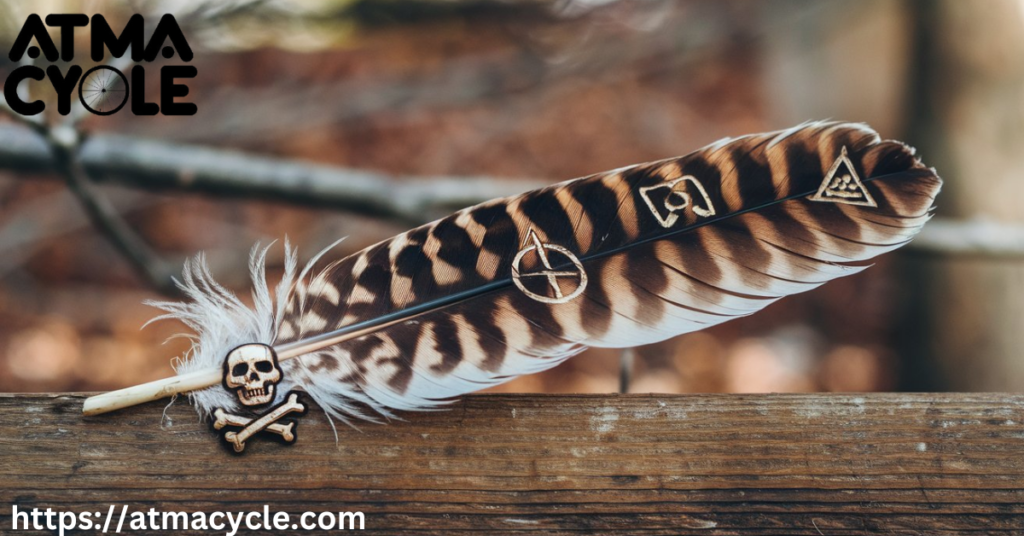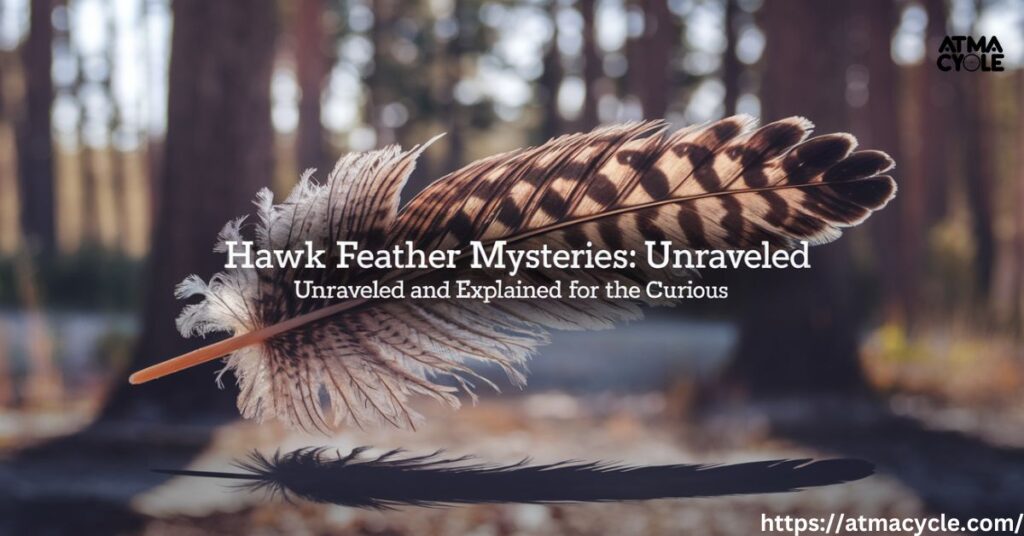Have you ever stumbled upon a hawk feather, its intricate patterns catching your eye as it lay nestled in the grass? If so, you’re not alone in feeling a sense of wonder and curiosity about this natural treasure. Unraveling the mysteries of hawk feathers, from their structure to their significance, can be a fascinating journey for the curious observer.
Hawk feathers have captivated humans for centuries, sparking imagination and inspiring spiritual practices across cultures. In this comprehensive guide, we’ll explore the multifaceted world of hawk feathers, from their biological importance to their deep-rooted symbolism.
The Majestic Hawk: Nature’s Aerial Predator

Before we dive into the mysteries of hawk feathers, let’s take a moment to appreciate the magnificent birds they come from.
Hawks are renowned for their keen eyesight, powerful talons, and unparalleled flying skills. These raptors play a crucial role in maintaining ecological balance as top predators in many ecosystems.
Common Hawk Species and Their Habitats
Hawks are found on every continent except Antarctica. Here’s a quick look at some well-known hawk species:
| Species | Habitat | Notable Features |
| Red-tailed Hawk | North America | Brick-red tail, diverse color morphs |
| Cooper’s Hawk | North America | Slate gray upper parts, reddish barring on chest |
| Northern Goshawk | Northern Hemisphere | Fierce hunter, blue-gray plumage |
| Harris’s Hawk | Southwestern U.S., Central and South America | Social hunters, dark brown plumage |
The Crucial Role of Feathers in a Hawk’s Life
Feathers are more than just decorative; they’re essential for a hawk’s survival. Here’s why:
- Flight: Specially shaped flight feathers provide lift and maneuverability.
- Insulation: Downy feathers trap air close to the body, regulating temperature.
- Protection: Tough contour feathers shield the hawk from the elements and minor injuries.
- Camouflage: Feather patterns help hawks blend into their surroundings.
- Communication: Feather displays play a role in courtship and territorial behavior.
Decoding the Symbolism of Hawk Feathers

Hawk feather symbolism is rich and varied across cultures. These powerful birds have long been associated with qualities like vision, freedom, and spiritual awareness.
Ancient and Modern Interpretations
- In ancient Egypt, the hawk was associated with Horus, the sky god.
- Greek mythology linked hawks with Apollo, the god of prophecy and truth.
- Modern spiritual practices often view hawk feathers as symbols of clarity and perspective.
“The hawk is a messenger of spirit – of the higher self, of intuition, and of the universe.” – Unknown
Hawk Feathers in Native American Cultures
Native American hawk feather symbolism is particularly profound. Many indigenous communities revere hawks as spiritual messengers and incorporate their feathers into sacred objects and ceremonies.
- Cherokee Hawk Feather Interpretation Cherokees associate hawk feathers with protection and courage.
- Plains Indigenous groups often use hawk feathers in war bonnets, symbolizing bravery and skill in battle.
- Southwestern Indigenous groups view hawk feathers as symbols of healing and wisdom.
Global Perspectives on Hawk Symbolism
Hawk feathers hold significance beyond North America:
- In Celtic tradition, hawks represent freedom and far-sightedness.
- Chinese culture associates hawks with persistence and achievement.
- African folklore often portrays hawks as clever tricksters or wise advisors.
The Spiritual Significance of Hawk Feathers
For many, finding a hawk feather is more than a chance encounter – it’s a spiritual experience. Let’s explore the deeper meanings often attributed to these feathers.
Hawk Feathers as Messengers from the Spirit World
Some believe that finding a hawk feather is a sign from the universe or spirit guides. It might indicate:
- A need to pay attention to your surroundings
- Confirmation that you’re on the right path
- A reminder to trust your instincts
Their Role in Meditation and Mindfulness Practices
Hawk feathers and intuition often go hand in hand in spiritual practices. Some ways they’re used include:
- Focal points: Meditating on a hawk feather to enhance concentration
- Energy tools: Using feathers in energy healing practices like Reiki
- Ritual objects: Incorporating feathers into smudging or cleansing rituals
Personal Growth and Self-Discovery

Many people find that contemplating hawk feathers leads to personal insights:
- Broadening perspectives: Like a hawk’s aerial view, feathers may inspire you to see the bigger picture.
- Enhancing intuition: Hawk feathers are thought to sharpen intuitive abilities.
- Encouraging bravery: The hawk’s fierce nature can inspire courage in facing challenges.
Hawk Feathers in Art and Craft
The beauty of hawk feathers has inspired artists for generations. From traditional crafts to modern art pieces, these feathers continue to captivate creators and audiences alike.
Traditional Uses in Various Cultures
- Native American headdresses: Hawk feathers adorn ceremonial headpieces.
- Dreamcatchers: Feathers are often attached to these protective charms.
- Smudge fans: Used to direct smoke in cleansing rituals.
Modern Artistic Expressions
Contemporary artists incorporate hawk feathers in diverse ways:
- Jewelry: Feather-inspired pendants and earrings
- Photography: Close-up studies of feather patterns and textures
- Mixed media: Combining feathers with paint, fabric, or digital elements
Ethical Considerations in Feather Art
While hawk feathers are undeniably beautiful, it’s crucial to approach their use in art ethically:
- Use alternatives: Synthetic or legally obtained feathers from non-protected species
- Photography and digital art: Capture feather beauty without physical possession
- Education: Create art that raises awareness about hawk conservation
The Science Behind Hawk Feathers
Understanding the biology of hawk feathers adds another layer of appreciation for these natural wonders.
Feather Structure and Function
Hawk feathers are marvels of natural engineering:
- Rachis: The central shaft, providing strength
- Barbs: Branches from the rachis
- Barbules: Smaller branches from barbs
- Hooklets: Tiny structures that “zip” barbules together
This intricate structure allows for both strength and flexibility, crucial for flight.
How Hawks Molt and Regenerate Feathers
Hawks undergo a process called molting to replace worn feathers:
- Molting usually occurs annually
- Feathers are typically lost and regrown symmetrically
- The process can take several months to complete
The Aerodynamics of Hawk Flight
Hawk feathers are specifically adapted for efficient flight:
- Primary feathers: Located at wingtips, provide thrust
- Secondary feathers: Inner wing feathers, provide lift
- Tail feathers: Act as a rudder for steering and braking
Legal and Ethical Considerations
While the allure of hawk feathers is undeniable, it’s essential to understand the legal and ethical implications of collecting them.
Laws Protecting Hawks and Their Feathers
In the United States, hawks are protected under the Migratory Bird Treaty Act (MBTA). This means:
- It’s illegal to possess hawk feathers without proper permits
- Penalties can include fines and even imprisonment
The Migratory Bird Treaty Act Explained
The MBTA, enacted in 1918, protects over 1,000 bird species, including hawks. Key points:
- Prohibits the taking, possession, sale, or transport of protected birds or their parts
- Applies to both live birds and feathers, nests, or eggs
- Exceptions exist for certain Native American religious practices
Ethical Ways to Appreciate Hawk Feathers Without Possession
You can still enjoy the beauty of hawk feathers responsibly:
- Photography: Capture images of feathers you find in nature
- Birdwatching: Observe hawks in their natural habitat
- Nature centers: Visit facilities that may have legally obtained feathers for educational purposes
- Art appreciation: Enjoy feather-inspired art and crafts
Conservation Efforts for Hawks
Protecting hawks and their habitats is crucial for ensuring these magnificent birds continue to soar in our skies.
Current Threats to Hawk Populations
Hawks face numerous challenges in the modern world:
- Habitat loss due to urbanization and deforestation
- Pesticide use affecting prey populations
- Climate change altering migration patterns and breeding grounds
- Collisions with vehicles and structures
Organizations Working to Protect Hawks
Several dedicated groups are fighting for hawk conservation:
- The Peregrine Fund: Focuses on raptor conservation worldwide
- Hawk Mountain Sanctuary: Conducts research and education programs
- National Audubon Society: Advocates for bird protection and habitat conservation
How Individuals Can Contribute to Hawk Conservation
You can play a part in protecting hawks:
- Support conservation organizations through donations or volunteering
- Create hawk-friendly spaces in your yard by avoiding pesticides
- Advocate for bird-safe building designs in your community
- Educate others about the importance of hawks in ecosystems
The Hawk Feather Experience

Encountering a hawk feather can be a powerful experience. Here’s how to make the most of it while respecting nature and the law.
What to Do If You Find a Hawk Feather
- Observe and appreciate: Take time to study its beauty
- Document the experience: Take photos or make sketches
- Leave it be: Remember, it’s illegal to take the feather with you
- Reflect: Consider what message or meaning this encounter might hold for you
Creating a Mindful Practice Around Feather Sightings
Turn hawk feather encounters into opportunities for personal growth:
- Journaling: Record your thoughts and feelings about the experience
- Meditation: Use the memory of the feather as a focus for mindfulness practice
- Art: Create feather-inspired artwork to commemorate the encounter
Connecting with Nature Through Hawk Appreciation
Hawk feathers can be a gateway to deeper nature connection:
- Learn to identify different hawk species in your area
- Participate in local birding events or hawk watches
- Support wildlife rehabilitation centers that care for injured hawks
Conclusion: The Enduring Mystery of Hawk Feathers
From their biological importance to their spiritual significance, hawk feathers continue to captivate our imaginations. Whether you’re drawn to their scientific marvels, artistic potential, or symbolic meaning, these feathers offer a unique connection to the natural world.
As we’ve explored, appreciating hawk feathers doesn’t require possessing them. By understanding their importance, respecting the laws that protect them, and finding ethical ways to celebrate their beauty, we can ensure that hawks continue to thrive – and that future generations can experience the wonder of finding a hawk feather in the wild.
FAQs
Q: How can I tell if a feather is from a hawk?
A: Hawk feathers are typically broad with rounded tips. They often have barred patterns and can range from light brown to dark chocolate in color. However, precise identification can be challenging and is best left to experts.
Q: What’s the difference between eagle and hawk feathers?
A: Eagle feathers are generally larger and have a more pronounced curve. Hawk feathers tend to be straighter and have different color patterns. Both are protected under the MBTA.
Q: Can I keep a hawk feather I’ve found?
A: In the United States, it’s illegal to possess hawk feathers without proper permits due to the Migratory Bird Treaty Act. It’s best to leave any feathers you find in nature.
Q: What does it mean if I keep seeing hawk feathers?
A: Some believe repeated hawk feather sightings are a sign to pay attention to your intuition or that you’re on the right path in life. However, interpretations can vary based on personal beliefs and cultural backgrounds.
Q: Are some hawk feathers considered luckier than others?
A: In some traditions, certain feathers might be considered more significant. For example, a perfectly intact feather or one found at a meaningful time might be seen as especially lucky. However, all hawk feathers are protected equally under the law.







